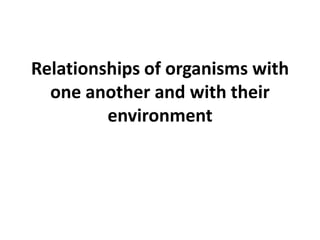
Relationships between organisms and their environments through nutrient cycles
- 1. Relationships of organisms with one another and with their environment
- 3. NUTRIENT CYCLES • Carbon cycle • Water cycle • Nitrogen cycle
- 4. CARBON CYCLE
- 6. CARBON CYCLE REMOVAL OF CO₂ FROM THE ATMOSPHERE • PHOTOSYNTHESIS: uses light energy to convert CO₂ into organic compounds in plants. ADDITION OF CO₂ TO THE ATMOSPHERE • RESPIRATION: converts carbohydrates to CO₂ with the release of energy. • DEATH AND DECAY: provide plant and animal material for decomposers – bacteria and fungi. • COMBUSTION: releases CO₂ by the burning of fossil fuels. FOSSILISATION: The hydrocarbon fuels, such as coal and petroleum, come from ancient plants which have only partly decomposed over the million of years since they were buried.
- 7. WATER CYCLE
- 11. NITROGEN CYCLE 1)PROCESSES WHICH ADD NITRATES TO SOIL • Nitrifying bacteria: they use ammonia fron excretory products and decaying organisms as a source of energy. In this process they produce nitrates. There is a special group, the nitrogen-fixing bacteria, which can absorb N₂ as a gas from the air spaces in the soil, and build it into compounds of ammonia, which can be easily be changed to nitrates by other nitrifying bacteria. Some of these live in the roots nodules of leguminous plants (peas,beans, clover).
- 12. 1)PROCESSES WHICH ADD NITRATES TO SOIL (cont) • Lightning: lightning discharges makes some of the nitrogen gas in the air combine with oxygen, forming nitrogen oxides. They dissolve in rain, and are washed into the soil, where they form nitrates.
- 13. 2)PROCESSES WHICH REMONVE NITRATES FROM THE SOIL • Uptake by plants: plant roots absorb nitrates from the soil and combine them with the carbohydrates to make proteins. • Leaching: as rain water passes through the soil it dissolves the nitrates and carries them away in the run-off or to deeper layers of the soil. • Denitrifying bacteria: They obtain energy by breaking down nitrates to nitrogen gas which then escapes from the soil into the atmosphere.
- 14. POPULATION SIZE • POPULATION: group of organisms of one species, living in the same area at the same time.
- 18. HUMAN INFLUENCES ON THE ECOSYSTEM • AGRICULTURE • POLLUTION • CONSERVATION
- 20. POLLUTION • WATER POLLUTION by sewage and chemical waste. • AIR POLLUTION by: - sulfur dioxide. - greenhouse gases - nitrogen oxides • POLLUTION DUE TO PESTICIDES AND HERBICIDES. • POLLUTION DUE TO NUCLEAR FALL-OUT
- 21. POLLUTION OF WATER: the 2 pollutants that reduce oxygen in water are: • Fertilisers: nitrates and phosphates are added to the soil by farmers. Some are washed from the soil by rain into the nearest pond, lake or river. This process is called leaching. • Sewage: contains an excellent source of organic food from bacteria, and also contains phosphates from detergents.
- 23. AIR POLLUTION • BY SULFUR DIOXIDE and NITROGEN OXIDES: contributes to acid rain. • BY GREENHOUSE GASES CONTIBUTING TO GLOBAL WARMING. Carbon + O₂ → carbon monoxide (CO) and carbon dioxide (CO₂) Sulphur + O₂ → sulphur dioxide (SO₂) Nitrogen + O₂ → nitrogen monoxide (NO) and nitrogen dioxide (NO₂)
- 24. Greenhouse effect:gases contributing GAS % ESTIMATED MAIN SOURCES CONTRIBUTION Carbon dioxide 55 Burning fossil fuels Methane 15 Decay of organic matter; waste gases from digestive processesin cattle and insects; natural gas leaks CFCs (chlorofluorocarbons) 24 Refrigerators and air conditioning systems; plastic foams Nitrogen oxides 6 Fertilisers; burning fossil fuels, especially in vehicles.
- 30. Pollution due to nuclear fall-out • IONISING RADIATION MAY CAUSE CANCER Accidents at nuclear power stations may release substances into the atmosphere. Exposure to large amounts of radiation from these substances can cause radiation sickness and burns. They can also increase mutation rates in DNA in our cells, which may lead to cancer. - Alpha particles - Beta particles - Gamma rays